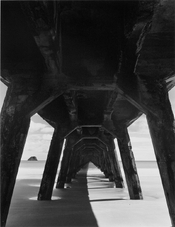There is usually no problems, until there are, of course. Such as static discharges in humid conditions.
A tale of woe and warning. While bicycling for a half-year in New Zealand with my 4x5, I kept the exposed film in the bags in the film boxes. It can be wet in NZ, and back then the roads were much rougher. So on the extreme end of the possibility of this kind of damage happening.
While dampness does suppress static from building up, one can still get static discharges from the film moving against itself while riding bumpy roads in warm wet conditions. But instead of streaks of light, it is localize discharges. The longer the exposed film was sitting in the box exposed, the more likely were my chances of damage. Also, as more film was added to the boxes during the trip, the less the film could move around. The below image was taken early in the trip and this 16x20 takes about 4 hours of spotting to clean it up.
Prevention -- Pack something in the box to keep the film from moving around. If I had been using Ilford film back then (1986/7). I could have used the sheets of paper between each sheet of film, which might have helped.











